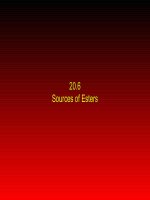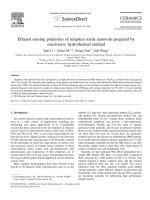Rlectromagnetic properties of multi-configuration of gold nano cluster absorber in infrared regime
Bạn đang xem bản rút gọn của tài liệu. Xem và tải ngay bản đầy đủ của tài liệu tại đây (474.03 KB, 7 trang )
HNUE JOURNAL OF SCIENCE
DOI: 10.18173/2354-1059.2019-0037
Natural Sciences, 2019, Volume 64, Issue 6, pp. 108-114
This paper is available online at
ELECTROMAGNETIC PROPERTIES OF MULTI-CONFIGURATION
OF GOLD NANO CLUSTER ABSORBER IN INFRARED REGIME
Tran Manh Cuong1, Kieu Huyen Trang1, Do Hoang Tung2,
Nguy The Cuong3 and Pham Van Dien4
1
Faculty of Physics, Hanoi National University of Education
Institute of Physics, Vietnam Academy of Science and Technology
3
JSC Investment and Education Publishing, Vietnam Education Publishing House
4
Military Logistics Academy, Long Bien, Hanoi
2
Abstract. Nanotechnology plays an increasingly important role in research as well
as the advancement of science and technology. Current studies of nanoparticle or
nanocluster are mainly concentrated due to important electromagnetic properties
emerged in this domain. This study presents the investigations on the nature of
electromagnetic wave absorption in the Infrared regime (IR) that is comparable
with the metamaterial absorber of the gold-nano-particle nanocluster structure with
different single-particle forms and configurations. Research shows that the
electromagnetic response appears to be good for optical sensor or energy
harvesting application.
Keywords: Gold nanoparticle, absorber metamaterial, reflection coefficient, THz, Infrared.
1. Introduction
Absorber metamaterial is a new kind of metamaterial that could totally absorb all
energy impinges on its surface [1]. The word “meta” means beyond therefore the term
“metamaterial” refers to beyond conventional materials. Since their first design,
absorber metamaterials have become the topic of many emerging research directions [2-6].
The unusual dispersion characteristics of metamaterials are typically achieved using
carefully designed the geometry and shape of structure. These engineered metamaterials
can manipulate electromagnetic fields as desired [1]. Through the clever design of metamolecules, metamaterials could exhibit a wide interesting range of physic properties,
such as negative index, cloaking, perfect absorption and many more. Usually, unit cells
(UC) of many metamaterials that are designed to operate at optical frequencies are made
Received June 18, 2019. Revised June 22, 2019. Accepted June 29, 2019.
Contact Tran Manh Cuong, e-mail address:
108
Electromagnetic properties of multi-configuration of gold nano cluster absorber in infrared regime
of nano unit cell metals such as gold, silver, copper, etc. [7, 8]. By exciting
thesestructure with an external EM field, Surface Plasmon Polaritons (SPPs) are
generated in the metal or metal/dielectric surfaces. These SPPs are the collective
oscillations of conduction electrons in response to the field incident on the structure.
This can generate the resonance of the absorber to the incoming wave then perform the
perfect absorption peak at some frequency ranges [9, 10].
The study of electromagnetic and chemical properties of nanoparticles has been
concentrated long time ago by many groups worldwide [7-10]. However, the collection
of these particles, which is also named nanocluster, has not been widely studied on this
topic. In this article, we examine nanoclusters formed by a group of 5 particles of 100300 nm radius range and the interaction of these clusters with electromagnetic waves at
the IR regime reaching their surface. The cluster with 5 particles is chosen for the ease
and convenience of investigating compared to other configuration when we study about
the distance between the nanoparticle. The results of the investigation of the change of
the particle radius, the distance of particles, and the defect of particle position are also
given and discussed in the report. The results of the study are important in applications
of nano IR optical sensor, plasmonic resonator and so on [9, 10]. The calculation in this
study was performed by using Finite-Integration Technique based on CST Microwave Studio.
2. Content
2.1. Result and discussion
In our study, nanoparticle clusters were placed with concordant boundary
conditions in the simulation setup. For the sake of simplicity and reasonable symmetric
degree, a model of 5-gold-nanoparticle with the radius of 100-300 nm is used. The
output of the stimulation contains scatting parameters including transmission coefficient
S12 and reflection coefficient S11. From these data, the absorption coefficient can be
determined by the following equation:
A = 1 – │S11│2 – │S12│2
In the part below, we discuss the absorption property of different configurations of
the nanogold cluster.
2.2. Different inter-particle distance
First, the distance between five particles is alternately 10 nm, 20 nm, 30 nm in
cluster configurations as shown in Figure 1. The radius of each particle is 100 nm. The
absorbing boundary condition is placed surrounding the cluster, a plane wave with a
definite frequency range in the IR (Infrared) regime is sent along the axis perpendicular
to the nano-cluster surface. From the simulation results, the reflection and transmission
coefficients of the structure are determined. These results are shown in Figure 2 below.
One can see that the absorption response depends on different configurations of nanocluster. Three clusters have different absorption responses in the IR frequency range.
Three main resonance points are observed at 260 THz, 245.30 THz, and 220.66 THz
109
Tran Manh Cuong, Kieu Huyen Trang, Do Hoang Tung, Nguy The Cuong and Pham Van Dien
(respectively for 10 nm, 20 nm, 30 nm distance particle cluster). When the distance
increases, the region of absorption is larger and the frequency is redshifted. The negative
value of the absorption response is also observed and this could be due to some errors
occurring when extracting the parameters from the scattering coefficients in the
calculation. This does not affect our absorption results.
Figure 1. Nano-cluster of (a) 10 nm-distance, (b) 20 nm-distance,
(c) 30 nm-distance
Figure 2. Absorption spectrum of three cluster configurations
In order to understand more about electromagnetism absorption mechanism, we
consider the electric field and magnetic field distribution around these particles at 260
THz, 245 THz and 220 THz respectively. The results are shown in Figure 3. It is clear
that the larger the distance is, the weaker the electric field and magnetic field is. The
field focuses on outside the particle, among these particles. From that, we concluded
that the absorption coefficient definitely depends on how gold-nanoparticle arrange in
the cluster. In this case, the absorption rate depends on the distance between the
particles. We can apply this characteristic for the optical sensor such as the detection of
different nanogold configuration by the absorption spectrum analyse. The absorption
performance of these clusters can also be used for the energy havester in the IR range.
110
Electromagnetic properties of multi-configuration of gold nano cluster absorber in infrared regime
Figure 3. Electric field and magnetic field distribution of three cluster type
2.3. Distance of the defect
Three configurations of this cluster are chosen to investigate, in each cluster, 4-gold
nanoparticles are fixed and another is placed at a different distance far from the others
of 10 nm, 20 nm, 30 nm, respectively (Figure 4). The radius of each particle remains 100 nm.
From simulation results in Figure 5, the absorption coefficient is changed when one
cluster is moved far from the others. To specific, the lowest peak is moved slightly to
the left - lower frequency. This means when we increase the distance between one
particle with the others, the frequency is red-shifted and the absorption band increases.
Figure 4. Configurations with 5-gold-particle cluster
111
Tran Manh Cuong, Kieu Huyen Trang, Do Hoang Tung, Nguy The Cuong and Pham Van Dien
Figure 5. Absorption spectrum of 3 configurations with 5-gold-particle cluster
We observe the concentration of electric and magnetic fields in the cluster structure
with the defect distant equal 20 nm at a resonant frequency to understand more about
resonance characteristics, as a case study. We choose the frequency of 350 THz at which
the absorption rate is high (~90%). The result is presented in Figure 6. We see that when
the particle moves far away, the distribution of the magnetic field of structure focuses
among 4 particles, and losing field with others. The electric field focus on the outside of
the particle. Therefore, the structure can absorb energy more efficiently.
Figure 6. Observation of electric (left) and magnetic (right) field distribution at
350 THz, the cluster with distance 20 nm
2.4. Change in particle radius
This study considers the structure of closely packed nanoparticle with the different
particle radius of 100 nm, 200 nm and 300 nm as shown in Figure 7. The absorption rate
is shown in Figure 8.
Figure 7. Gold nanoparticle with different radius (a) 100nm,
(b) 200 nm, (c) 300 nm
112
Electromagnetic properties of multi-configuration of gold nano cluster absorber in infrared regime
Figure 8. Absorption spectrum of 5-gold-particle cluster with different radius
As we can see that the clusters with the particle radius of 200 nm or 300 nm absorb
well in all range of the infrared region 180 - 380 THz with the absorption rate is over
80%. With the cluster of the nanoparticle r = 100 nm, it possesses a high absorption
range from the shore at f = 280 THz.
Figure 9. Observation of electric field distribution
at 280 THz of three types of 5-particle cluster
Figure 9 represents the distribution of the electric field in each structure at 280
THz, the larger the radius of particles is, the stronger the electric field focus among the
particles. At Figure 9a, most of the electric field concentrated outside the model, just a
little bit among them. Compare to (b) and (c) it is obvious that the color of the electric
field has changed, that means the strength of electric field increase. It can be
concluded that the larger nanoclusters absorb more efficiency.
3. Conclusions
In this report, by changing the configuration of the nanoparticle cluster, we can
alter the frequency range of the absorption spectrum. The distance between the
nanoparticle increases makes the absorption spectrum extend to the redshift. That can
explain by the electric field and magnetic field distribution among these particles.
The nearer the particles is, the weaker electric field and magnetic field between them.
The changing of the radius of the nanoparticle also affect on the absorption spectrum.
The larger the particle is, the stronger intensity of the absorption occurs. We proved that
by applying minor modifications in the position and shape of nanocluster, one can affect
113
Tran Manh Cuong, Kieu Huyen Trang, Do Hoang Tung, Nguy The Cuong and Pham Van Dien
significantly on the electromagnetic responses, which is promising for nanosensor
technology in the future.
Acknowledgements. This research was funded by the Vietnam National Foundation for
Science and Technology Development (Grant No. 103.99-2017.26).
REFERENCES
[1] Landy, N.I., Sajuyigbe, S., Mock, J.J., et al., 2008. Perfect metamaterial absorber,
Phys. Rev. Lett., 100, (20), p. 207402.
[2] F. Alves, D. Grbovic, B. Kearney & G. Karunasiri, 2012. Microelectromechanical
systems bimaterial terahertz sensor with integrated metamaterial absorber. Opt. Lett.,
37(11), 1886-1888.
[3] Manh Cuong Tran, Thi Thuy Nguyen, Tuan Hung Ho, and Hoang Tung Do, 2016.
Creating a Multiband Perfect Metamaterial Absorber at K Frequency Band Using
Defects in the Structure. Journal of electronic materials, doi: 10.1007/s11664-0164863-0.
[4] H. Tao, N. I. Landy, C. M. Bingham, X. Zhang, R. D. Averitt & W. J. Padilla,
2008. A metamaterial absorber for the terahertz regime: Design, fabrication and
characterization. Opt. Express, 16, 7181-7188.
[5] G.D. Wang, M.H. Liu, X.W. Hu, L.H. Kong, L.L. Cheng & Z.Q. Chen, 2013.
Broadband and ultra-thin terahertz metamaterial absorber based on multi-circular
patches. Eur. Phys. J. B., 86, 304.
[6] X. Wang, G.-Z. Wang, and L.-L. Wang, 2016. Design of a novel dual-band
terahertz metamaterial absorber, Plasmonics, Vol. 11, No. 2, pp. 523-530.
[7] Saïd Bakhti et al., 2016. Fano-like resonance emerging from magnetic and electric
plasmon mode coupling in small arrays of gold particles. Scientific Reports 6
32061,. Doi: 10.1038/srep32061.
[8] Sardana N, Talalaev V, Heyroth F, Schmidt G, Bohley C, Sprafke A, Schilling J.
2016. Localized surface plasmon resonance in the IR regime. Opt. Express 24 (1)
254-61. doi:64/OE.24.000254. />[9] B. Kearney, F. Alves, D. Grbovic & G. Karunasiri, 2013. Al/SiOx/Al single and
multiband metamaterial absorber for terahertz sensor applications. Optical
Engineering, 52(1), 013801.
[10] S., Racknoi, P. & Yupapin, 2017. P. Computational surface plasmonic microdevice for sub-wavelength switching and sensing applications. J. Opt, 46: 375.
/>
114









